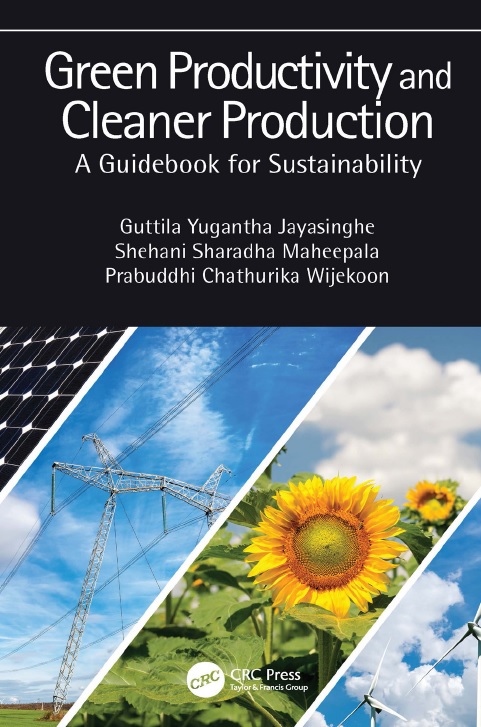By Guttila Yugantha Jayasinghe, Shehani Sharadha Maheepala and Prabuddhi Chathurika Wijekoon

Contents
Authors………………………………………………………………………………………………………..xi
Chapter 1 Basic Approach to Green Productivity ………………………………………….1
Guttila Yugantha Jayasinghe, Shehani Sharadha Maheepala, and Prabuddhi Chathurika Wijekoon
1.1 A Basic Approach to Green Productivity……………………………..1
1.2 Productivity……………………………………………………………………..1
1.3 Sustainability……………………………………………………………………5
1.4 Sustainable Development Goals and Green Productivity……….7
References…………………………………………………………………………………9
Chapter 2 Green Productivity…………………………………………………………………… 11
Guttila Yugantha Jayasinghe, Shehani Sharadha Maheepala, and Prabuddhi Chathurika Wijekoon
2.1 Introduction…………………………………………………………………… 11
2.2 GP Methodology…………………………………………………………….. 16
2.2.1 Step 1: Getting Started………………………………………… 16
2.2.1.1 Task 1: Team Formation………………………… 16
2.2.1.2 Task 2: Walk-Through Survey and Information Collection………………………….. 17
2.2.2 Step 2: Planning…………………………………………………. 19
2.2.2.1 Task 3: Identification of Problems and Causes…………………………………………… 19
2.2.2.2 Task 4: Setting Objectives and Targets……..20
2.2.3 Step 3: Generation, Evaluation, and Prioritization of GP Options…………………………………………………….. 21
2.2.3.1 Task 5: Generation of GP Options…………… 21
2.2.3.2 Task 6: Screening, Evaluation, and Prioritization of GP Options…………………… 21
2.2.4 Step 4: Implementation of GP Options…………………..23
2.2.4.1 Task 7: Formulation of GP Implementation Plan………………………………23
2.2.4.2 Task 8: Implementation of Selected Option………………………………………………….24
2.2.4.3 Task 9: Training, Awareness Building, and Developing Competence…………………..24
2.2.5 Step 5: Monitoring and Review……………………………..26
2.2.5.1 Task 10: Monitoring and Evaluation of Results………………………………………………….26
2.2.5.2 Task 11: Management Review…………………27
2.2.6 Step 6: Sustaining GP…………………………………………..27
2.2.6.1 Task 12: Incorporation of Changes into Organizational System of Management……27
2.2.6.2 Task 13: Identification of New/Additional Problem Areas for Continuous Improvement………………………..28
References……………………………………………………………………………….29
Chapter 3 Green Productivity Tools and Techniques……………………………………31
Guttila Yugantha Jayasinghe, Shehani Sharadha Maheepala, and Prabuddhi Chathurika Wijekoon
3.1 Green Productivity Tools………………………………………………….31
3.1.1 Brainstorming…………………………………………………….31
3.1.1.1 The Benefits of Brainstorming ……………….32
3.1.2 Flowcharts………………………………………………………….32
3.1.2.1 Main Steps to Develop a Flowchart………….33
3.1.3 Process Flow Diagram…………………………………………34
3.1.4 Plant Layout………………………………………………………..34
3.1.5 Eco-Maps…………………………………………………………..35
3.1.5.1 Main Steps to Develop an Eco-Map…………36
3.1.6 Concentration Diagrams………………………………………37
3.1.6.1 Steps to Develop a Concentration Diagram……………………………………………….37
3.1.7 Check Sheets………………………………………………………38
3.1.8 Checklist…………………………………………………………….40
3.1.9 Material Balance…………………………………………………41
3.1.9.1 Steps to Develop a Material Balance………..42
3.1.10 Energy Balance…………………………………………………..42
3.1.10.1 Steps to Calculate an Energy Balance………44
3.1.11 Cause-and-Effect Diagram (Fishbone/Ishikawa diagram)…………………………………………………………….44
3.1.1.1 Steps to Develop a Cause-and-Effect Diagram……………………………………………….45
3.1.12 Control Charts…………………………………………………….45
3.1.13 Spider Web Diagram……………………………………………47
3.1.13.1 Steps to Develop a Spider Web Diagram…..47
3.1.14 Cost–Benefit Analysis………………………………………….48
3.1.14.1 Steps to Produce a Cost–Benefit Analysis……………………………………………….49
3.1.15 Benchmarking…………………………………………………….49
3.1.15.1 Typical Benchmarking Methodology……….49
3.1.16 Decision Matrix…………………………………………………..51
3.1.16.1 Steps to Develop a Decision Matrix…………51
vii
3.2 Green Productivity Techniques…………………………………………51
3.2.1 Improved Operating Procedures……………………………52
3.2.2 Waste Segregation……………………………………………….53
3.2.3 Good Housekeeping Practices………………………………54
3.2.3.1 Benefits of Good Housekeeping………………55
3.2.4 The 5S Technique………………………………………………..55
3.2.5 The Concept of 7 Wastes ……………………………………..55
3.2.5.1 Overproduction……………………………………..56
3.2.5.2 Waiting…………………………………………………56
3.2.5.3 Transporting…………………………………………57
3.2.5.4 Inappropriate Processing………………………..57
3.2.5.5 Unnecessary Inventory…………………………..57
3.2.5.6 Unnecessary/Excessive Motion……………….57
3.2.5.7 Defects…………………………………………………57
3.2.6 Preventive and Productive Maintenance (PPM)………58
3.2.7 Recycle, Reuse, and Recovery……………………………….59
3.2.7.1 Reuse……………………………………………………59
3.2.7.2 Recycle…………………………………………………59
3.2.7.3 Recover ……………………………………………….59
3.2.8 Energy Conservation……………………………………………60
3.2.9 Input Material Changes………………………………………..61
3.2.10 Process/Equipment Changes…………………………………61
3.2.10.1 Improving Operation Procedures…………….61
3.2.10.2 Equipment Modification…………………………61
3.2.10.3 Material Changes…………………………………..61
3.2.11 Pollution Control…………………………………………………62
3.2.11.1 Air Emission Control……………………………..62
3.2.11.2 Wastewater Management………………………..66
3.2.11.3 Solid Waste Management……………………….66
3.2.12 Design for the Environment………………………………….67
3.2.13 Life Cycle Assessment…………………………………………68
3.2.13.1 LCA Goal and Scope Definition………………69
3.2.13.2 Life Cycle Inventory (LCI) Analysis………..69
3.2.13.3 Life Cycle Impact Assessment (LCIA)…….70
3.2.13.4 Interpretation………………………………………..71
3.2.13.5 Uses of the Life Cycle Assessment Process…………………………………………………72
3.2.13.6 Data Analysis in the Life Cycle Assessment Process……………………………….73
3.2.13.7 Types of Life Cycle Assessment Process ….74
3.2.14 Green Purchasing………………………………………………..78
3.2.14.1 Benefits of Green Purchasing………………….78
3.2.14.2 Steps of Green Procurement……………………79
References……………………………………………………………………………….79
Chapter 4 End-of-Pipe Treatment Techniques……………………………………………..83
Guttila Yugantha Jayasinghe, Shehani Sharadha Maheepala, and Prabuddhi Chathurika Wijekoon
4.1 Waste Management…………………………………………………………83
4.2 End-of-Pipe Treatment…………………………………………………….84
4.2.1 Gaseous Waste Treatment…………………………………….85
4.2.1.1 Wet Scrubbers……………………………………….85
4.2.1.2 Dry Absorption (Dry Scrubbers)……………..90
4.2.1.3 Electrostatic Precipitators (ESPs)…………….92
4.2.1.4 Fabric Filters…………………………………………95
4.2.2 Liquid Waste Treatment……………………………………….97
4.2.2.1 Filtration (Membrane Separation)……………97
4.2.2.2 Aerobic Treatment…………………………………97
4.2.2.3 Anaerobic Treatment……………………………103
4.2.3 Solid Waste Treatment……………………………………….106
4.2.3.1 Thermal Treatment………………………………107
4.2.3.2 Sanitary Landfills ……………………………….111
4.2.3.3 Composting…………………………………………115
References……………………………………………………………………………..122
Chapter 5 Cleaner Production………………………………………………………………….125
Guttila Yugantha Jayasinghe, Shehani Sharadha Maheepala, and Prabuddhi Chathurika Wijekoon
5.1 Introduction………………………………………………………………….125
5.2 History of Cleaner Production Development…………………….125
5.3 Elements of Cleaner Production………………………………………126
5.4 The Cleaner Production Assessment Approach…………………127
5.4.1 Planning and Organization………………………………….127
5.4.2 Pre-Assessment and Assessment………………………….127
5.4.3 Feasibility Analysis……………………………………………128
5.4.4 Implementation………………………………………………….128
5.4.5 Continuation……………………………………………………..128
5.5 Benefits of a CP Program……………………………………………….129
5.6 Issues with the CP Technique………………………………………….131
5.7 National Cleaner Production Centers (NCPC)…………………..131
5.8 CP Policy……………………………………………………………………..131
5.9 Barriers………………………………………………………………………..132
References……………………………………………………………………………..133
Index………………………………………………………………………………………………………..135
Foreword
Green productivity (GP) and cleaner production (CP) strategies have been developed to simultaneously enhance both productivity and environmental sustainability. The application of green productivity tools and techniques in the appropriate procedure is important to improve the productivity and environmental performance of an organization and to ultimately achieve overall socio-economic development. GP is applicable not only in the manufacturing sector but also in the agricultural and services sectors. GP plays a vital role in addressing the interactions between economic activities and community development while acting on environmental protection and awareness in the public sector. GP and CP address all elements of a production system, including inputs, processes, outputs, and waste (including environmental pollution). It ensures that products or services meet customers’ requirements and that productivity is maintained or improved.
This book will encourage readers to realize the mistakes of conventional productivity, and equip them with an understanding of green productivity as one of the initial steps in commencing sustainability. It demonstrates the GP approach and outlines how to achieve sustainability in a methodical way through green productivity. This book will act not only as a textbook and reference material for academics of the sector but also as a tool for initiating sustainability within businesses and communities. It is an effort to describe the concept of green productivity and cleaner production in a convenient manner and is accessible to every level of reader who is interested in the topic. The green productivity methodology, tools, and techniques and cleaner production strategy described in the book enable reader to determine how they can contribute to the greening process.
